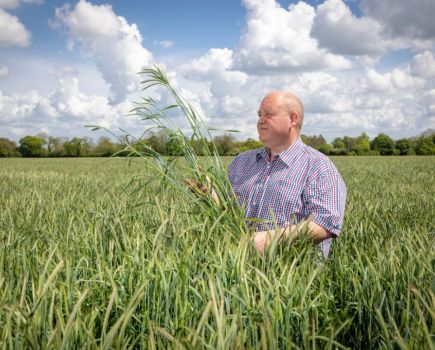If you use fungicides to control plant diseases like septoria in wheat, it will drive selection of resistant populations. A meaty AHDB-led project aims to find out the best way to keep the handbrake on this process. CPM finds out more.
We can have the freedom to mix or alternate fungicides, knowing that either strategy will help reduce selection pressure.
By Adam Clarke
Back in 2017, there was growing concern about septoria insensitivity to SDHIs, with the fungicide group’s performance wobbling against a backdrop of continued decline in DMI (azole) efficacy against the disease.
These factors were prompting leading crop pathologists to question whether growers should be applying two SDHIs in a season, which had become standard practice, and the routine use of azole-based T0s was also thrown into doubt.
Adding to sweaty palms – at least amongst the research community – was the realisation the approval of multi-site fungicide chlorothalonil, so long the lynchpin of septoria control and anti-resistance strategies, was on borrowed time.
This would potentially leave growers with just two main fungicide groups for controlling septoria, both acting on a single target site so more prone to sensitivity shifts in target populations.
ADAS director of crop protection Dr Neil Paveley says there was also understanding, from other diseases in different crops across the world, that pathogens can develop resistance against two or more single site modes of action concurrently.
This begged the question; what’s the best way is to slow any slide in efficacy when restrictions on multi-site fungicide use eventually arrived?
To find the answer, a comprehensive 54-month study was triggered to sharpen up resistance management advice and prolong the life of both existing and yet-to-be introduced fungicide molecules.
It concluded that, while current resistance management advice is sound, there may be scope to re-think how dose splitting and alternation of modes of action fit in fungicide programmes.
Monitoring fungicide performance and the sensitivity of pathogens to different active ingredients is a strategically important aspect of AHDB’s activity, and for that reason receives significant funding each year.
With help from scientific and industry partners, this complex area of work helps to inform growers on optimising fungicide use and managing resistance via the Fungicide Resistance Action Group (FRAG).
About six years ago, the ongoing monitoring work was picking up SDHI-resistant septoria isolates at low levels and Neil says the unease this caused, plus the window of opportunity to set up experiments it provided, led to the project’s inception.
“Researchers can only do experiments to investigate resistance when it’s happening and if isolates are at a high enough frequency to measure. So it was the perfect time to explore the impact of different resistance management strategies on selection pressure in septoria when using SDHIs and DMIs together.
“Although we tested septoria in the project, it was hoped the work would provide a model for a whole range of pathogens, too. Cercospora in sugar beet or light leaf spot in oilseed rape are just two examples,” he adds.
Selection pressure describes the influence exerted on a pathogen population that promotes one strain of an organism over another. In crop disease control, applying a fungicide kills susceptible pathogen isolates and leaves less susceptible or resistant ones behind.
The basic principles of managing this process have been established over a long period of time and make perfect sense – limit dose, mix different modes of action, or limit treatment frequency to reduce selection pressure, he explains.
However, these components of resistance management trade-off against one another, to some degree, adds Neil, which means there’s a tricky balance to strike when formulating regulatory policy (which affects what’s permitted according to the product label) and practical guidance.
For example, limiting the number of SDHI treatments – in the UK, SDHIs are limited to two and in France, just one – which reduces selection pressure and protects the SDHI mode of action. But the downside is it leaves less options for use in mixtures with other fungicide groups at other spray timings.
Neil says the work aimed to understand what impact splitting the total dose of SDHI would have on selection pressure, because allowing more flexibility in how many times a mode of action can be used may allow more room for mixing.
Studies in other parts of the world, in other pathogens and crops, suggest that splitting dose varies between no increase to a 30% increase in speed of selection for resistant strains. The reason for this variation is because there are two opposing things happening, he explains.
A lower dose of active in each application reduces selection pressure, but there is a longer exposure time of fungicide to pathogen because of more frequent treatments, which increases selection, says Neil. “Essentially, those two things are trading-off.”
From the experiments in the project, and previous work, it was seen that changing the total dose of SDHI applied made a big difference to selection pressure – so the more you apply, the faster resistance develops.
However, the work showed that the effect on selection pressure of splitting an SDHI fungicide’s total dose across multiple applications when controlling septoria is likely to be relatively small and contradicts some previous studies.
In practical terms, this provides a good argument for growers to continue using two applications of SDHI fungicide in a season where needed, providing the dose per application is no more than necessary, instead of UK regulators following the French route of just one application.
In the future, where a fungicide manufacturer wanted to make a practical case for a single site active’s total dose to be split over more treatments, it could help provide more flexibility without driving selection pressure up.
Away from this new understanding of dose splitting, the study confirmed the established benefits of mixing different modes of action through a fungicide programme.
This was considered an effective and practical way to provide mutual protection between fungicide groups, but the project discovered that alternating modes of action is as effective at reducing selection pressure.
“It means that we can have the freedom to mix or alternate fungicides, knowing that either strategy will help reduce selection pressure,” says Neil.
“This can be particularly useful in crops which require multiple sprays in a season, such as for potato blight control.”
He adds that understanding and implementing these principles is key as new molecules are introduced, with cereal growers benefitting recently from the introduction of BASF’s mefentrifluconazole and Corteva’s QiI active, fenpicoxamid.
There’s also a strong pipeline of other single site fungicides on the horizon that it’s imperative to protect, including new generation SDHIs from Bayer (isoflucypram) and Syngenta (adepidyn), adds Neil.
While the project used the now obsolete multi-site fungicide chlorothalonil in some of its experiments, the remaining multi-sites will have a key role in this protection, he says.
“For septoria control, that comes down to folpet and sulphur-based products. There has been a lot of debate about the cost of folpet in programmes, but ADAS analysis over the past three years has shown a net economic benefit from its inclusion.
“It’s a win-win. Although it’s possible for resistance to develop to multi-sites, it takes a long time. So you get protection of the single sites with little risk of resistance to the multi-site itself,” he explains.
The overarching message on fungicide resistance is clear – the less fungicide applied, the lower the selection pressure, so the overall aim should be to optimise inputs without losing gross margin.
In the past, minimising this economic risk when controlling septoria in wheat hasn’t been straightforward, with growers largely planting susceptible varieties, comments Neil. This meant that without high fungicide input, or if application timings went awry, the potential for a significant epidemic and yield loss was high.
However, Neil says that with increased uptake of IPM – for septoria this would include more resistant varieties and later drilling – there is a more even balance between risk and reward.
“The cost of undertreating is now closer to the cost of overtreating, so when you make mistakes, it’s less damaging.
“If you look at the AHDB Recommended List data, there is a big variation across varieties in the size of response to fungicides. Effectively, where there is a big response, they are the varieties where misjudging the risk will really cost you,” he says.
Planting varieties with strong resistance to septoria will help reduce inputs and there are now plenty of options available as breeders bring through material with high untreated yields. Using variety blends is another alternative which has become widely adopted in other European countries, suggests Neil.
So, there are tools to help reduce fungicide input, from robust individual varieties to variety blends, perhaps drilled late from mid-October. However, the million-dollar question is: how much fungicide do you really need?
Neil says this is a question only the grower and/or advisor can answer, using a mix of trials data and local knowledge of risks. However, he believes decision support systems to help judge disease risk have been significantly underutilised.
Disease modelling has suffered with lack of investment over recent decades, as growers have had highly effective fungicides to control disease. Any predictive models produced have often been met with a large degree cynicism, too, he adds.
More recently, two promising septoria models have been well-tested in parts of Northern Europe – one primarily based on rainfall and the other humidity – and have shown promise in predicting disease.
“Those models would be well worth testing here in the UK and the more IPM practices are adopted, the better the economics of predictions models become.
“You’d have been a brave person to rely on a prediction system growing Consort or Riband, but growers are planting varieties with much higher disease ratings now and the risks become much more manageable,” he concludes.
Study reinforces industry advice
Despite recent fungicide losses, cereal growers now have access to new DMI and QiI chemistry, with the potential of more approvals being granted by regulators soon. To prolong their effective life, it’s vital that the successful resistance management strategies outlined in the project are put into action on farm, according to Syngenta’s Jason Tatnell.
“The project was complex to plan and run, but it’s given us an in-depth validation of the resistance management strategies outlined by FRAC and FRAG,” he adds.
In essence, that’s limiting total dose of fungicide through the season, mixing modes of action, and using multi-sites in partnership with single sites to keep epidemics in check and ease selection pressure.
However, finding out that alternation of modes of action across a fungicide programme can be as effective as mixing at reducing selection pressure was a bit of a surprise in the pathosystem tested, he says.
“I think there may have been an assumption that mixtures are better than alternation, whether that’s between timings or between seasons. Ultimately, alternation is likely to remain less common than mixing, but this does raise awareness and will see us challenging ourselves on that a bit more,” explains Jason.
Dose splitting was investigated within the project and for septoria resulted in only a small increase in selection pressure for a given mode of action. This opened a discussion amongst project stakeholders about trade-offs and whether dose splitting for one mode of action may offer better protection to another, he explains.
However, evidence suggested there was no net positive impact of this kind, so Jason reiterates that the project has validated current guidance.
“There isn’t a great argument for changing guidance where cereal fungicides are concerned, but in other crop-disease systems, further dose splitting research could throw up a benefit.
“An example would be crops where many more sprays are required in a season and chemistry is limited, so you may not always have the options that allow you to tank mix throughout the programme,” he adds.
His final take-home message from the project is the high value of multi-site fungicides in disease control and resistance management, justifying Syngenta’s advice to include folpet in wheat and barley programmes, he believes.
In wheat, he says this has greatest value at T1, but where septoria pressure is high then its addition at T2 is also beneficial. It has also shown its worth in ramularia programmes in Syngenta barley trials.
“Farmers have some highly effective tools for controlling wheat and barley diseases at present and there may be more to come, but they are all single sites and at risk from resistance development.
“The more we can do to slow that down, the better, and that includes using multi-sites. Be as compliant with FRAG guidance as you can,” he cautions.
Research roundup
From Theory to Field is part of AHDB’s delivery of knowledge exchange on grower-funded research projects. CPM would like to thank AHDB for its support and in providing privileged access to staff and others involved in helping put these articles together.
For further info:
AHDB Project No PR637: ‘Managing resistance evolving concurrently against two or more modes of action to extend the effective life of new fungicides’ was project managed by Dr Caroline Young and carried out by ADAS in partnership with Rothamsted Research, NIAB, SRUC and Teagasc at a cost of £196,500 to AHDB.




